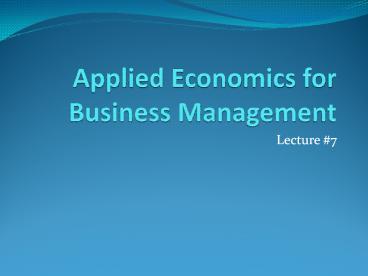Applied Economics for Business Management PowerPoint PPT Presentation
Title: Applied Economics for Business Management
1
Applied Economics for Business Management
- Lecture 7
2
Lecture Outline
- Review
- Go over Exam 1
- Continue production economic
- theory
3
Maximizing Profit
Using the previous example, lets now solve for
the input levels which maximize profits.
Maximizing profit ?
4
Maximizing Profit
1st order conditions
5
Maximizing Profit
For the first partial derivative
For the second partial derivative
6
Maximizing Profit
2nd order conditions
and
? Profits are maximized when
7
Maximizing Profit
Summary Least cost combinations and profit
maximization.
8
Maximizing Profit
Summary Least cost combinations and profit
maximization.
Maximizing output subject to a cost constraint
9
Minimizing Cost
Minimizing cost subject to an output constraint
Profit maximization
10
Expansion Path
An expansion path is a locus of points which
represent the tangencies between isoquant and
isocost lines assuming that input prices are
constant. Note that these tangencies are least
cost combinations. Since the tangencies
represent points where slopes of isoquant and
isocost lines are equal, we can solve for the
equation of the expansion path Slope of
isoquant
11
Expansion Path
Slope of isocost line
Using our previous production example
12
Expansion Path
? equation of the expansion path
Points of the expansion path are least cost
combinations of inputs.
13
Expansion Path
(so the least cost solutions lie on the expansion
path)
14
Expansion Path
What about the profit max solution?
So the profit max solution is a least cost
solution which lies on the firms expansion path.
15
Duality
The two constrained optimization methods,
constrained output maximization and constrained
cost minimization, yield a unique relationship
called duality. It implies the possibility of
deriving cost functions from production functions
and vice versa. Given the same cost and
production constraints, we see that both problems
(constrained output maximization and constrained
cost minimization) can yield the same optimal
combinations of inputs
16
Lagrange Multiplier
However, the other bit of information the
Lagrange multiplier is different yet related. For
the constrained output maximization problem,
In the constrained minimization problem,
17
Problem
The following production function, based on
actual Iowa experimental data, has been altered
slightly to simplify computations
18
Problem
Given the above production function and input
prices, what is the least cost combination to
produce a 240 pound hog?
19
Problem
This is a problem of constrained cost
minimization.
Why? Because costs are in cwt and 240 lbs
2.4cwt
1st order conditions
20
Problem
Solve for ? From the first equation
21
Problem
From the second equation
22
Problem
23
Problem
or
24
Problem
- Least cost combination Feed 448 lbs of corn
and 80 lbs - of soybean meal to produce a 240 lb hog
(2.4 cwt)
25
Homogeneous Functions
The function is said
to be homogeneous of degree k if each
independent variable (the xs for this function)
is multiplied by a scalar ?, and the dependent
variable (in this case y) changes by ?k. So the
function is homogeneous of degree k if
26
Example
Find the degree of homogeneity for this
function. If the function is homogeneous then we
can write
- the function is homogeneous
- of degree 2 (HD2)
27
Example
What does this mean?
If inputs x1 and x2 are increased by a factor ?,
then output (y) will increase by ?2.
28
Cobb-Douglas Form
Another example case of Cobb- Douglas form
Find the degree of homogeneity for this function.
29
Cobb-Douglas Form
Linearly homogeneous production functions are HD1
or HD 1 General Cobb-Douglas production
function
is homogeneous of degree
Another example
30
Cobb-Douglas Form
Is this function homogeneous and of what degree?
However, we can not get back to ?ky. So this
function is not homogeneous.
31
Factor (Input) Demand Functions
The demand for final products is derived from
constrained utility maximization (objective
function of consumers). The demand for inputs
is derived from profit maximization (objective
function of producers). Take the case of
production with one variable input
32
Factor (Input) Demand Functions
Recall first order conditions for profit
maximization
We can write the factor demand for input x1 as
33
Factor (Input) Demand Functions
Changes in r1 can be represented as movements
along the input demand function. Changes in p
can be represented as shifts of the input demand
function. Generally, output price is a positive
shifter of the input demand function.
34
Factor (Input) Demand Functions
We can graph the input demand function for x1 by
assuming p is held constant. We call the input
demand function the derived demand function since
it is a result of (or derived from) profit
maximization. So the input demand function is
often called the derived demand function since it
is derived from profit maximization. For the one
variable input case (factor-product case),
economic theory states that the factor demand
function is that portion of the VMP or MVP curve
in Stage II.
35
What is the law of demand? Does it hold for
inputs? Yes. The law of demand underlies the
negative relationship between own price and
quantity demanded for final products as well as
inputs.
36
What about input demands for the factor-factor
case? Given the following production function
37
Assume also that p is output price, r1 is the per
unit cost of x1 and r2 is the per unit cost of
x2. Derive the factor demand function for
x1. Input or factor demands are derived from
profit maximization.
38
1st order conditions
Solving for x2
39
(No Transcript)
40
In a similar manner, one can derive the factor
demand for x2. Is the factor demand function for
x1 downward sloping?
41
Is output price, p, a positive shifter of the
input demand function?
So if output price increases ? demand for x1
increases
42
What effect does changes in r2 have on the input
demand for x1?
43
Own price elasticity of demand

